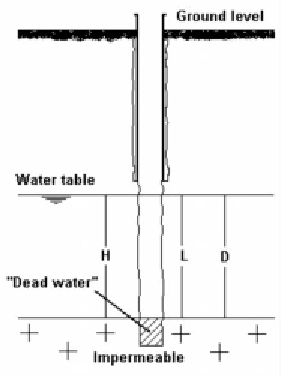Geology Reference
In-Depth Information
Well Geometry and Aquifer Thickness
In Bouwer & Rice slug test method, the well and aquifer geometries are
required for calculation of
K
(Fig. 2). Thus the aquifer thickness should be
well known before analysis and interpretation of slug test.
In these slug tests campaigns, the aquifer geometry has been determined
from the geological observations during well drillings. The bottom of the
aquifer corresponds to the top of the massive granite layer. This is supported
by flowmeter tests, which show that transmissive fractures exist only above
the fresh basement (massive grey granite). For data processing, well thickness
in massive grey granite (below aquifer zone) is not used for calculation of
K
. Water in this well portion is considered as “dead water”.
The different well parameters required for the determination of the
parameter
R
e
are
L
,
H
and
D
detailed in Fig. 2.
L
is the height of the portion
of well through which water enters,
H
is the total height of the well in the
aquifer and
D
is the aquifer thickness (
L
$
H
$
D
). In fact, there are four
cases for the geometry of bore-wells. Both extreme cases are illustrated in
Fig. 2. If the well is partially penetrating,
H
is inferior to
D
; if the well is
completely penetrating,
H
is equal to
D
. In Maheshwaram, in most of the
cases, the wells are fully penetrating thus
H
=
D
.
The value of
L
is dependent on the casing depth: if the casing reaches the
water table,
L
is inferior to
H
. On the contrary, if the casing doesn't reach
the water table,
L
=
H
.
Figure 2.
Different geometries of observation wells.


